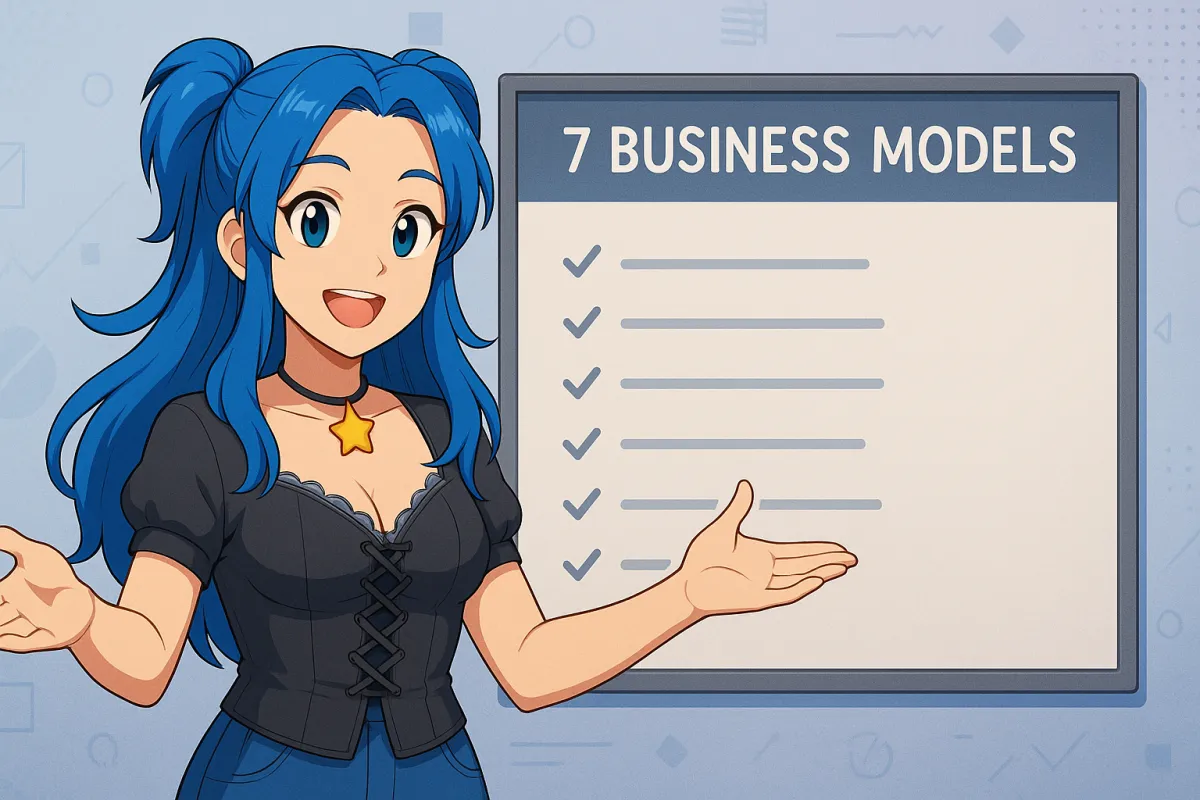
How Online Businesses Actually Make Money (And Why It Matters More Than You Think)
The Business Model Question Nobody Asks
Here's a question most people skip right over when starting a business: "How does this actually make money?"
Not in a vague "I'll sell something and people will buy it" way. In a concrete, specific way. What exactly are you selling? Who pays for what? When does money come in? What does your day-to-day work actually look like based on how you make money?
Most entrepreneurs pick a business model without realizing they're picking a business model. They see someone else doing something that looks good, they copy the format, and then they're surprised when their daily life doesn't match what they expected.
You thought you were building a coaching business, but you're actually spending 90% of your time creating course content.
You wanted the freedom of a product business, but you're stuck in custom client work.
You launched a membership thinking it would be passive income, and now you're scrambling to create fresh content every single week to prevent churn.
Here's what nobody tells you: The business model you choose doesn't just determine how money comes in. It determines what you do all day, how much energy you spend, who you interact with, how predictable your income is, and whether you can ever take a vacation without everything falling apart.
And here's the thing that really gets me fired up — most business advice acts like the model you choose is a minor detail. They focus on your offer, your positioning, your messaging (all important things, don't get me wrong), but they skip right over "how does this actually work day-to-day?"
Then you're six months in and you realize you built something that doesn't fit how your brain works, doesn't match your energy patterns, and is slowly bleeding into every other area of your life in ways you didn't expect.
So let's fix that. Let's break down how online businesses actually make money, so you can understand the landscape you're operating in — whether you're building your own business or working with entrepreneur clients.
The Seven Primary Business Models
Every online business falls into one of seven primary models (or combines multiple models). Each one has completely different characteristics, challenges, and daily realities.
1. Service-Based Businesses
What it is: You sell your time, expertise, or implementation work. The client has a problem, you solve it through direct work with them.
Examples:
Coaching and consulting
Copywriting and content creation
Web design and development
Virtual assistance
Bookkeeping and financial services
Marketing services (social media management, ad management, SEO)
Business strategy and operations consulting
How money works: Client pays for your time and expertise. Usually project-based fees, hourly rates, or retainers. Quick vocab note: A retainer is a monthly recurring payment for ongoing access to your services — think of it like a subscription to you.
What your days look like: Client calls and meetings. Doing the actual work (writing, designing, implementing, coaching). Managing client relationships. Custom work tailored to each specific client's needs.
The upside: High profit margins because your main cost is your time. Direct relationships with clients. Ability to charge premium rates for expertise. Flexibility to pivot or customize. Can start with basically zero upfront investment.
The challenge: Your income is directly tied to your time. Hard to scale without hiring a team or raising rates significantly. Every client is somewhat custom. Takes ongoing effort to deliver. If you stop working, money stops coming in.
This model works best if you:
Love working directly with people and building relationships
Thrive on customization and problem-solving
Have expertise people will pay premium rates for
Don't mind that your income requires ongoing active work
Can manage the energy of client interaction and delivery
Reality check: This is where most entrepreneurs start because it's the lowest barrier to entry. You can literally start tomorrow if you have expertise someone will pay for. But it's also where people get stuck, because the one-to-one nature makes it hard to grow without fundamentally changing your business model. And here's what the gurus won't tell you — that's actually okay. Not every business needs to scale to seven figures. Some of the most profitable, sustainable businesses are service-based with premium pricing and a small roster of ideal clients. Don't let anyone shame you for building a service business.
2. Product-Based Businesses (Physical)
What it is: You sell tangible goods that get shipped to customers. Could be products you make, products you source, or products you design and manufacture.
Examples:
Handmade goods (jewelry, art, crafts)
Print-on-demand merchandise
Private label products (your brand on manufactured goods)
Dropshipping (selling products you don't physically handle)
Subscription boxes with physical products
E-commerce stores
How money works: Customer pays for product plus shipping. You pay for cost of goods, packaging, shipping, platform fees, payment processing, and marketing. The difference is your profit. Quick business term: This difference between what you charge and what it costs you is called your margin.
What your days look like: Product creation or sourcing. Inventory management. Order fulfillment (or managing fulfillment). Customer service. Marketing and content creation. Dealing with returns, damaged products, shipping issues.
The upside: Can be very scalable if systems work well. Each sale doesn't require your direct time. Potential for passive-ish income once systems are in place. Can sell same product to unlimited customers.
The challenge: Upfront costs for inventory or production. Shipping logistics and costs. Returns and customer service issues. Thin profit margins in competitive markets. Storage and inventory management. Physical products break, get lost, arrive damaged.
This model works best if you:
Enjoy or can systematize operational logistics
Have capital to invest upfront (or can start small and reinvest)
Don't need high margins on each sale (volume game)
Can handle the complexity of supply chain management
Are okay with physical product realities (damage, returns, shipping delays)
Reality check: Many people romanticize product businesses ("build it once, sell it forever!") but the operational reality is complex. You're essentially running a mini supply chain. It can work beautifully, but it's not as passive as it looks from the outside. Between inventory management, shipping logistics, customer service, and dealing with returns or damaged products, there's more ongoing work than most people expect.
3. Product-Based Businesses (Digital)
What it is: You sell information, templates, or tools in digital format. Once created, can be sold unlimited times with no additional production cost.
Examples:
Online courses and programs
E-books and digital guides
Templates (spreadsheets, designs, documents, workflows)
Digital planners or workbooks
Video or audio training programs
Software tools or apps (when sold as one-time purchase)
Stock photos, graphics, or design assets
Notion templates, Canva templates, etc.
How money works: Create once, sell many times. Customer pays, receives instant access. No shipping costs. Main costs are platform fees, payment processing, and marketing. Very high profit margins once creation costs are recouped.
What your days look like: Creating the product (can be substantial upfront time investment). Marketing and content creation to drive sales. Customer support and questions. Updating products based on feedback or changes. Sales funnels and email sequences.
The upside: Extremely high profit margins. True scalability — serve 10 customers or 10,000 with same effort. No inventory or shipping concerns. Can be genuinely passive income once systems are established. Low overhead costs.
The challenge: Crowded market. Standing out requires excellent marketing. High upfront time investment to create quality products. Customer completion rates are often low (for courses/programs). Requires ongoing marketing to maintain sales. Refunds can happen if expectations don't match reality.
This model works best if you:
Are good at marketing and building audience
Can invest significant upfront time without immediate return
Don't need high-touch client interaction
Are okay with low completion rates (most course buyers don't finish)
Can create content that stands alone without you explaining it
Have patience for the long game (building audience takes time)
Reality check: This is the "dream" for many entrepreneurs, but let's get real — the market is saturated. Success requires either exceptional marketing, a strong existing audience, or a very specific niche. The "create once, sell forever" promise is semi-real, but getting people to buy and actually use what you created is the hard part that you have to continue to work at. And here's the thing nobody mentions: watching people buy your course and never complete it can be demoralizing. Low completion rates are normal in this industry, but that doesn't make them feel good.
4. SaaS (Software as a Service)
What it is: Subscription-based software that solves a specific problem. Customers pay monthly or annually for ongoing access.
Vocab note: SaaS stands for Software as a Service. It's pronounced "sass" and it means the software lives in the cloud (you access it online) rather than downloading it to your computer.
Examples:
Project management tools (Asana, ClickUp, Monday)
Email marketing platforms (ConvertKit, Mailchimp)
Course platforms (Kajabi, Teachable)
CRM systems (HubSpot, Salesforce)
Design tools (Canva, Figma)
All-in-one business platforms (FableForge Suite)
Scheduling tools (Calendly, Acuity)
Accounting software (QuickBooks, FreshBooks)
How money works: Recurring revenue. Customer pays monthly or annual subscription. They keep paying as long as they keep using it. This creates predictable, recurring revenue. Business term: MRR means Monthly Recurring Revenue — the total amount of subscription revenue you can expect each month.
What your days look like: Product development and improvements. Technical maintenance and bug fixes. Customer support. Feature development based on customer feedback. Marketing to acquire new customers. Customer success work to prevent cancellations.
The upside: Recurring revenue is predictable and compounds over time. Keep customers happy, and they keep paying. Extremely scalable once built. High lifetime value per customer. Quick term: LTV or Lifetime Value means the total amount a customer pays you over the entire time they're a customer. Can grow to be very valuable business. Less dependent on constant new sales if retention is good.
The challenge: Significant upfront development costs (time or money). Technical complexity. Ongoing maintenance required. Customer acquisition costs can be high. Churn can kill growth. Vocab note: Churn means cancellation rate — the percentage of customers who stop paying each month. Must constantly improve product to compete. Requires technical skills or budget to hire developers.
This model works best if you:
Have technical skills or capital to hire developers
Can handle significant upfront investment before revenue
Understand you're playing a long game (years, not months)
Can manage technical complexity and ongoing maintenance
Focus heavily on customer retention (reducing churn)
Have patience for the compounding effect of recurring revenue
Reality check: SaaS businesses are capital-intensive to start (whether that capital is money or time). They're also incredibly competitive. But if you can get one working, the recurring revenue model is powerful. Many entrepreneurs build service businesses that generate cash, then invest that cash into building SaaS products that are aligned with their services. Oftentimes, they'll build a SaaS that makes their services easier to deliver or that provides value to potential clients that might not be ready for their services yet.
5. White Label/Reseller Models
What it is: You sell someone else's product or service under your own brand. You're not building the core product — you're adding your brand, your positioning, your customer relationships, and often your unique implementation or support on top of an existing solution.
Vocab clarification: White label means you're reselling under your brand. Private label typically refers to physical products with your branding. PLR (Private Label Rights) means digital content you can rebrand and sell as your own.
Examples:
White label SaaS: Reselling software under your brand (like FableForge Suite, which is built on HighLevel's platform but branded and positioned uniquely)
Agency reselling: Reselling another agency's services while you build your own team
White label courses or content: Licensing PLR content to rebrand and sell as your own
White label physical products: Private label goods where manufacturer's brand is replaced with yours
Reseller partnerships: Selling enterprise software or services with your implementation layer
How money works: You pay the original provider (either upfront licensing fee, monthly/annual fee, or percentage of what you charge). You charge your customers your own pricing. The difference is your margin. You control the pricing and customer relationship.
What your days look like: Marketing and sales under your brand. Customer onboarding and support (adding your unique value). Implementation or training that differentiates your offering from the white label source. Managing relationship with white label provider. Building your brand positioning around the solution.
The upside: Much lower barrier to entry than building from scratch. Can get to market quickly with proven solution. You focus on marketing, sales, and customer relationships rather than product development. Can test market demand before investing in building your own. Can eventually bring in-house once you've proven model and have resources.
The challenge: Limited control over core product features or roadmap. Dependent on white label provider's stability and quality. Margins can be thinner than owning the product outright. Must differentiate through positioning, service, or implementation since core product isn't unique. If provider raises prices or changes terms, your business is affected.
This model works best if you:
Want to test market demand before building from scratch
Have strong marketing and sales skills
Can differentiate through positioning, service, or implementation
Are comfortable not controlling the core product
See this as strategic stepping stone or permanent model
Can add genuine value beyond just marking up someone else's product
Strategic use case — The build vs. buy question:
Many successful entrepreneurs use white label as a stepping stone. You start by reselling to prove market demand and generate revenue. Once you've validated the model and built cash flow, you can either continue reselling if the economics work well, negotiate better terms with your provider as you grow, or eventually build or acquire your own version to own the full margin and control.
Real-world example: Kasim Aslam (founder of Solutions 8) built one of the largest Google Ads agencies in the world. He started by reselling another agency's services — they did the fulfillment, he did sales and client relationships. As he grew, he negotiated an agreement with them to help train his staff so he could bring fulfillment in-house. Eventually sold the agency for an eight-figure exit. The white label model let him prove the market, generate revenue, and build before taking on the complexity of full in-house operations.
Reality check: White label gets a bad reputation sometimes ("you're just reselling someone else's stuff"), but it's a legitimate strategic choice. The key is adding genuine value — your positioning, your implementation, your support, your customer relationships. If you're just marking up someone else's product with no additional value, that's weak. If you're creating a differentiated experience on top of a white label foundation, that's smart business strategy.
6. Hybrid Models
What it is: Combining multiple business models to create more revenue streams and stability.
Examples:
Coach who also sells courses (service + digital product)
Agency that offers both done-for-you services and DIY templates (service + digital product)
Software company that also offers implementation services (SaaS + service)
Course creator who also does group coaching (digital product + service)
Designer who sells templates and custom design work (digital product + service)
E-commerce store with membership component (physical product + subscription)
How money works: Multiple revenue streams from different sources. Some months service revenue is higher, some months product revenue is higher. Creates more stability than single-income-stream businesses.
What your days look like: Varies significantly based on which components you're balancing. Usually involves switching between different types of work (client delivery, product creation, marketing for different offers).
The upside: Diversified income reduces risk. Can serve customers at different price points. Leverages your expertise in multiple ways. Some revenue streams more active, some more passive. Can transition between models as business grows.
The challenge: Can feel scattered or overwhelming. Requires managing multiple business models simultaneously. Marketing becomes more complex. Risk of doing several things poorly instead of one thing well. Can be harder to explain what you do.
This model works best if you:
Have successfully run at least one model already
Can handle complexity and multiple priorities
Have systems to manage different business streams
Add strategically rather than randomly
Can clearly explain what you do despite multiple offers
Have energy and capacity for varied work
Reality check: Most successful entrepreneurs end up with hybrid models eventually. You start with one model, it works, you add another. The key is adding strategically, not just throwing more things at the wall. Done well, hybrid models create both stability and growth as you meet clients where they need you in multiple ways. Done poorly, they create chaos and burnout for you and confusion for your potential clients. If you're considering a hybrid model, make sure your first revenue stream is working smoothly before you add a second one. Don't use "adding another offer" as a way to avoid fixing problems in your current business.
7. Marketplace/Platform Businesses
What it is: You create a platform that connects buyers and sellers. You don't provide the service or product yourself — you facilitate transactions between other people.
Examples:
Freelance platforms (Upwork, Fiverr)
Course platforms (Teachable, Thinkific when used by multiple creators)
E-commerce platforms (Etsy, Amazon for third-party sellers)
Service marketplaces (Thumbtack for local services)
Affiliate networks
Community platforms with paid expert access
How money works: Usually take a percentage of each transaction, or charge sellers/service providers for platform access, or both. Revenue scales with transaction volume on your platform.
What your days look like: Platform maintenance and development. Recruiting and supporting sellers/service providers. Marketing to attract buyers. Ensuring quality control. Handling disputes and customer service for both sides. Building features that make transactions easier.
The upside: Extremely scalable once both sides of marketplace are active. Revenue grows with transaction volume, not your direct effort. Can become very valuable if network effects kick in. Not dependent on you being the expert or service provider.
The challenge: Chicken-and-egg problem (need sellers to attract buyers, need buyers to attract sellers). Requires significant scale to be profitable. Complex to build and maintain. Quality control issues. Two customer bases to serve (buyers and sellers). High upfront investment required.
This model works best if you:
Have significant technical and financial resources
Can solve the chicken-and-egg problem creatively
Already have a network or audience in a specific space
Understand you're playing an extremely long game
Can handle serving two different customer bases
Have patience for the scale required to be profitable
Reality check: Marketplace businesses are the hardest to get off the ground but can be the most valuable if successful. Most entrepreneurs don't start here — they build expertise in an area first, then create platforms that serve that space. Not recommended as a first business model unless you have significant technical and financial resources.
3 Common Licensing & Certification Models
These are specialized revenue models that leverage intellectual property and methodology. They're less common but incredibly powerful when done well.
1. Franchise Model
What it is: Someone pays you to replicate your entire business system. They get everything — your brand, processes, training, ongoing support. Think McDonald's, but for any type of business.
How money works: Franchisee pays upfront franchise fee (often $20K-$100K+) plus ongoing royalties (percentage of revenue, usually 5-10%) and sometimes marketing fees.
Examples: Mostly physical businesses (restaurants, gyms, retail), but some service franchises exist (cleaning services, tutoring centers, senior care).
Reality check: This is a massive undertaking that requires proven business success, comprehensive systems documentation, legal structures, and significant capital. Not relevant for most online entrepreneurs, but good to understand the concept.
2. Licensing Model
What it is: Someone pays you for the right to use your methodology, framework, curriculum, or intellectual property. They implement it under their own brand.
How money works: Usually upfront licensing fee plus ongoing royalties, or revenue share, or flat annual fee. Less expensive than franchise because they're not getting your entire business system and brand.
Examples:
Licensing your curriculum to other trainers who teach it
Licensing your methodology to consultants who implement it
Licensing your framework to agencies who use it with their clients
Licensing content or templates to platforms who distribute them
When this makes sense: You've developed a methodology or framework that works reliably, and you want to scale through other people implementing it. You focus on the intellectual property, they focus on the delivery.
Reality check: You need proven intellectual property that people want to pay for. This usually comes after years of refining your methodology and getting strong results. It's a way to scale expertise without doing all the delivery yourself.
3. Certification Programs
What it is: You train people in your methodology and give them a credential that demonstrates their expertise. They pay for the training and certification.
How money works: Participants pay for training program (anywhere from $1K to $20K+). Some programs also charge annual recertification fees or require ongoing education.
Two different uses:
Adding credibility to existing work: Marketing agency that gets StoryBrand certified to add credibility and methodology to their existing services. They were already doing marketing; certification gives them a recognized framework and differentiator. Certification is a tool, not their entire business.
Making certification the business model: Someone becomes a Certified StoryBrand Guide and builds their entire business around offering StoryBrand workshops and implementation. The certification IS their business model. They're using someone else's methodology and paying them a portion of their revenue.
Examples:
StoryBrand Certified Guide
Certified EOS Implementer (Entrepreneurial Operating System)
ICF coaching certifications
DiSC or Kolbe certified facilitators
Certified Profit First Professional
The upside (for certification creators): Highly scalable way to spread your methodology. Creates community of practitioners who refer to each other. Revenue from both training and ongoing fees. Builds movement around your approach.
The upside (for people getting certified): Instant credibility and methodology. Access to community and resources. Proven framework instead of reinventing wheel. Marketing support from certification organization.
The challenge (for certification creators): Requires robust training program and quality control. Must maintain standards across all certified practitioners. Legal complexity around intellectual property. Significant upfront investment to build.
The challenge (for people getting certified): Can be expensive investment. May require ongoing fees or revenue share. You're building someone else's brand alongside your own. Not always necessary or valuable depending on your market.
Reality check: Certification programs work best when there's a recognized, valuable methodology worth learning. As a business strategy, creating a certification program comes much later, after you've proven your methodology works. Getting certified in someone else's program can be a smart strategic move if it fills a gap in your expertise and serves your ideal clients.
2 Alternative Revenue Models
These aren't standalone business models but ways to generate revenue that often complement the primary models above.
1. Affiliate/Referral Programs
What it is: You recommend products or services to your audience, and you earn a commission when they buy.
How money works: Company pays you percentage of sale (usually 5-50% depending on product type and margin). Some pay per lead (someone signs up for free trial), some pay per sale.
Examples:
Amazon Associates (recommend products, earn percentage)
Software affiliate programs (recommend tools you use)
Course affiliate programs
Service referral partnerships
When this works well:
You have an engaged audience who trusts your recommendations
You genuinely use and recommend these products/services anyway
The commission is substantial enough to be worth the effort
You're strategic about what you promote (not promoting everything)
When this doesn't work:
You don't have an audience yet
You promote things just for commission without genuine belief in them
Your audience sees through the money motive
The products don't actually serve your people well
Reality check: Affiliate income can be a nice supplementary revenue stream, but it's rarely a primary business model on its own (unless you're building a content/review site with significant traffic). It works best when you're already creating content and naturally reference tools and resources. Don't build a business around affiliate income unless you're prepared to play the traffic volume game.
2. Membership/Subscription Models
What it is: Ongoing access to content, community, or resources for a recurring monthly or annual fee.
How money works: Members pay monthly or annually for continued access. Revenue compounds as you retain existing members and add new ones.
Examples:
Community memberships with monthly calls and resources
Content libraries with ongoing additions
Newsletter subscriptions with premium content
Accountability or masterminds with recurring access
Resource libraries (templates, training, tools)
The upside: Recurring revenue is predictable. Compounds over time if retention is good. Lower price point can attract more people than high-ticket offers. Can build strong community and relationships.
The challenge: Requires ongoing content or value creation. Churn (cancellations) can be demoralizing and financially challenging. Must balance "enough value to stay" with "not burning yourself out creating content." Can feel like a content hamster wheel if not designed well.
Reality check: Memberships sound great in theory (recurring revenue!) but the reality is complex. Most memberships struggle with retention. People join with good intentions, then life happens and they forget they're members or stop engaging. Success requires either exceptional community or consistent value delivery that people actually use. Don't launch a membership without a clear plan for what makes people stay.
The Lies You've Been Told About Business Models
Let's get real about some of the bullshit advice floating around about business models.
Lie #1: "Passive income should be your goal"
Here's the truth: Truly passive income doesn't exist in the way it's marketed. Even digital products require ongoing marketing. Even memberships require content creation. Even affiliate income requires audience building. What people call "passive income" usually means "income that's not directly tied to your hours" — which is different than passive.
And you know what? Active income from service businesses can be incredibly profitable and fulfilling. Stop letting people shame you for building a business model that requires your ongoing participation. Some of the wealthiest, most successful entrepreneurs run service-based businesses with premium pricing and small client rosters.
Lie #2: "You need to pick ONE model and stick with it forever"
Most successful businesses evolve. You start with services, add products later. You begin with products, add service components for implementation support. That's normal strategic evolution, not lack of focus.
The key is evolving intentionally — adding a second revenue stream when the first one is working, not using "new business model" as a way to avoid fixing problems in your current one.
Lie #3: "Everyone should have a course"
No. Not everyone should have a course. Not everyone's expertise translates well to self-paced learning. Not everyone has (or wants to build) the audience size needed to make course sales profitable. Not everyone enjoys creating content that works without them explaining it live.
Course creation has been sold as the holy grail of online business, but the reality is that the market is saturated and most courses have terrible completion rates. If you love teaching in a high-touch way, don't force yourself to create low-touch products just because someone said you should.
Lie #4: "Service businesses don't scale"
Service businesses scale differently than product businesses, but they absolutely scale. You can scale through premium pricing (fewer clients, higher rates). You can scale through team building (hiring deliverers while you focus on strategy). You can scale through group programs (one-to-many service delivery). You can scale through productizing your services (systematizing delivery for predictability).
Different doesn't mean worse. It means different.
Lie #5: "Just copy what worked for [insert guru name]"
What worked for them might not work for you. Their business model fit their working style, their energy patterns, their strengths, their market, their timing, their resources, their life circumstances.
You're not them. Your business needs to fit YOUR wiring, YOUR energy, YOUR life, YOUR strengths, YOUR market.
Stop trying to copy someone else's business model and expecting it to feel good. Of course it doesn't fit — it wasn't designed for you.
How to Choose Your Business Model (Decision Framework)
If you're building a business (or redesigning one that's not working), here are the questions to ask yourself:
About Your Working Style:
Do you love or dread direct client interaction?
Do you prefer deep customization or systematic repeatability?
Can you handle the pressure of launching and marketing consistently?
Do you have energy for ongoing content creation?
How do you feel about technical complexity?
About Your Energy Patterns:
Do you have consistent daily energy or does it fluctuate?
Can you maintain weekly/monthly content creation indefinitely?
Do you need variety or prefer predictable routines?
How quickly do you recover from intense work periods?
Does client interaction energize or drain you?
About Your Strengths:
Are you better at relationships or systems?
Do you excel at custom problem-solving or creating frameworks others can follow?
Are you more comfortable with technical work or people work?
Do you prefer selling high-ticket to few people or lower-ticket to many?
Are you naturally good at marketing and audience building?
About Your Life:
What does your ideal day actually look like?
How many hours can you realistically work?
Do you need predictable income or can you handle variability?
Can you invest significant upfront time before seeing revenue?
Do you need to be able to step away (vacations, health issues, family needs)?
About Your Market:
What does your ideal client actually need (not just what they say they want)?
What are they already buying successfully?
What price points work in your market?
How much education does your market need before they buy?
What delivery method would serve them best?
Red flags that your current model isn't serving you:
You dread Mondays (or whatever day you do your core work)
You're constantly exhausted in ways that don't match your workload
You resent your clients or customers
You fantasize about completely different business models
Your business stress is bleeding into your relationships and health
You feel trapped rather than free
You're working more but making the same (or less) money
Your business requires you to be "on" in ways that don't match your energy
When to pivot vs. optimize:
Optimize your current model if:
The model itself fits your working style
The problem is systems, pricing, or positioning (fixable things)
You're getting results for clients/customers
You're just hitting a predictable growth challenge
Consider pivoting if:
The daily reality fundamentally doesn't fit how you work
You've optimized everything and still feel miserable
The model requires sustained energy patterns you don't have
You're forcing yourself to be someone you're not
How to add a second model strategically:
Make sure your first revenue stream is working smoothly
Choose a complementary model that serves the same audience
Add in a way that leverages existing assets (content, audience, expertise)
Test small before going all-in
Have systems in place before launch
Don't use "new model" as avoidance of fixing current problems
Why Understanding Business Models Matters
If you're building your own business, understanding these models helps you make strategic choices about what you're actually building. Not just "I want to be a coach" but "I want to run a service-based business with potential to add digital products later." Not just "I want to create a course" but "I want to build a digital product business with low ongoing time commitment."
The business model you choose determines:
What your daily work looks like
How much time you need to invest
When and how money comes in
How scalable your business can be
What skills you need to develop
What kind of support or team you'll need
Whether you can take a vacation without everything falling apart
What your tech systems need to support
If you're working with entrepreneur clients, understanding business models helps you understand their world. A coach building a service business has completely different needs than someone launching a SaaS product. A course creator faces different challenges than a consultant. When you understand their business model, you understand their priorities, their challenges, and how to actually help them.
The Model Matters More Than You Think
Here's what most people get wrong: They think the business model is a minor detail. They focus on their offer, their positioning, their messaging — all important things — but they skip right over "how does this actually work day-to-day?"
Then they're six months in and realize:
They built a service business but wanted location freedom (service businesses require availability during client hours)
They created a membership but hate the ongoing content pressure
They launched a course but miss the human interaction
They're doing custom client work but wanted scalability
They built a SaaS but weren't prepared for the technical complexity
The business model isn't just about money. It's about the life your business creates for you.
A service business can be incredibly profitable and fulfilling if you love working directly with people and customizing solutions. It can also be draining and limiting if you crave scalability and passive income.
A digital product business can create genuine passive income and freedom if you're good at marketing and okay with lower completion rates. It can also feel empty and disconnected if you need regular human interaction.
A hybrid model can create stability and serve your strengths if designed well. It can also create scattered overwhelm if you're trying to do too many things at once.
There's no "best" business model. There's only what works for how you want to live, what you're good at, what energizes you, and what your market actually needs.
And here's the permission you might need to hear: You're allowed to change course. You're allowed to realize six months (or six years) in that the model you chose doesn't fit. You're allowed to evolve. You're allowed to pivot. Most successful entrepreneurs do.
The difference between staying stuck and moving forward is understanding WHY your current model isn't working — and making strategic choices about what to change.
Key Takeaways
Business models aren't just about money. They determine your daily life, your time commitment, your scalability, and your stress level.
There's no "best" model. Each model has different strengths and challenges. What matters is alignment with how you want to work and what your market needs.
Most successful businesses evolve. You might start with one model and add others over time. Service businesses add products. Product businesses add services. That's normal and often strategic.
Understanding models helps you make informed choices. Whether you're building a business or working with clients who run businesses, knowing how these models work helps you understand the landscape you're operating in.
The model you choose shapes everything else. Your pricing, your marketing, your systems, your team needs, your daily schedule, your tech requirements — all flow from the fundamental business model.
You're not stuck forever. If your current model isn't working, you can evolve. Understanding why it's not working helps you make strategic changes rather than just throwing new things at the wall.
What to Do With This Information
If you're building your own business:
Take the free Tech Stack Audit to understand how your business model affects your tech needs: fableforgesuite.com/tech-stack-audit
Different business models require different systems. A service business needs CRM and scheduling. A course business needs a learning platform. A hybrid model needs integrated systems that talk to each other. Understanding your model helps you choose tech strategically rather than accumulating tools randomly.
Join the free BLUEprint Business Lab to design a business that fits your actual wiring: bpbizlab.com
In the Lab, we work through the BLUEprint framework that helps you design your business around how you actually work — not how someone else told you to work. Understanding business models is just one piece. Understanding how to design a model that serves YOUR life is where transformation happens.
Book a Sprint Session if you're stuck and need expert eyes on your specific situation: christinahooper.com/sprint
Sometimes you need someone who's seen the patterns to help you figure out what's actually wrong. Is your business model the problem? Or is it your systems, your pricing, your positioning? A Sprint Session ($800) gives you expert diagnostic and 30 days of support to implement the solution.
If you're working with entrepreneur clients:
Understanding their business model helps you serve them better. The research needs for a service-based consultant are different than for a course creator. The validation process for a SaaS product is different than for a membership program. When you understand how their business makes money, you understand what they actually need from you.
The business model matters more than most people realize. It's not just about revenue — it's about building a business that fuels your life instead of draining it.








